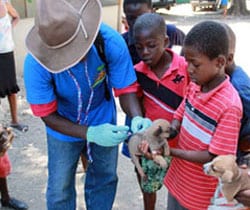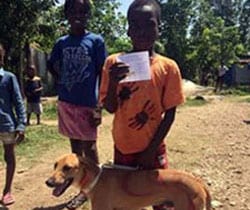Global Rabies Work

An estimated 59,000 people die from rabies each year, nearly half of whom are children. Rabies claims the life of one person every 9 minutes, putting it among the deadliest of all global zoonotic diseases, or diseases that are transmitted between animals and people.
Human rabies is primarily contracted from the bite of an infected dog, making canine vaccinations an important prevention strategy. Canine-spread rabies has been well controlled in developed countries through mass vaccination of dogs. The United States eliminated canine rabies in 2007. However, 122 developing countries still have dog-mediated human rabies deaths. In these countries, mass canine vaccinations are either not possible or extremely difficult, making containment of the disease challenging.
Haiti is one of five remaining countries in the Americas where canine rabies is still a problem. Battling the disease close to America’s borders, Haiti has the highest rate of human rabies deaths in the Western Hemisphere, with an estimated two deaths each week. In recent years, two people have died from rabies in the United States after being bitten by dogs in Haiti. In response to Haiti’s rabies epidemic, CDC’s Poxvirus and Rabies Branch (PRB) began a series of interventions to address rabies prevention and containment in Haiti. PRB has created a unique system of strong partnerships with the Haitian ministries of health and agriculture, Humane Society InternationalExternal
PRB and partners have taken a two-tiered approach to rabies control in Haiti, focusing on both development of dog vaccination programs and development of an Integrated Bite Case Management (IBCM) system to provide better treatment for bite victims. Today, the program in Haiti has seen great success:
- Haiti now has 92 veterinary professionals conducting animal rabies surveillance nationally.
- The IBCM program has increased animal rabies surveillance detection 16-fold, decreased the risk of dying from rabies by 49%, and increased post-bite rabies vaccination adherence by 230%.
- Over 260,000 children have received community education about rabies since 2014.
PRB’s surveillance and training partnerships in Haiti are creating a replicable framework to address the disease in other rabies-endemic countries. In February 2017, CDC hosted rabies vaccine coordinators from Haiti, Guatemala, and Mission RabiesExternal

While the United States invested hundreds of millions of dollars in the elimination of canine rabies, the threat is not gone. The two most common rabies threats to the United States are importing canines into the United States and infection of US citizens traveling abroad in rabies-endemic countries. To ensure the United States remains free of dog-mediated rabies, it is critically important to control the virus in countries that might spread the rabies virus back to the US By replicating the successful framework created in Haiti, US borders and travelers from the US remain safe from the threat of rabies at home and traveling abroad.
To support this effort, PRB has conducted a global needs assessment to make progress towards canine rabies elimination by 2030, as proposed by the World Health Organization, the OIE-World Organisation for Animal Health, and the Food and Agriculture Organization. While this analysis found expected gaps to achieve this elimination goal, they were not insurmountable and pragmatic steps have been suggested to stimulate the global effort. To assist globally, PRB has applied the lessons learned in Haiti to support the development of a regional planning group for rabies in East Africa and establishment of programs in Vietnam.
To view a printable version of this page: Global Rabies Work Cdc-pdf
